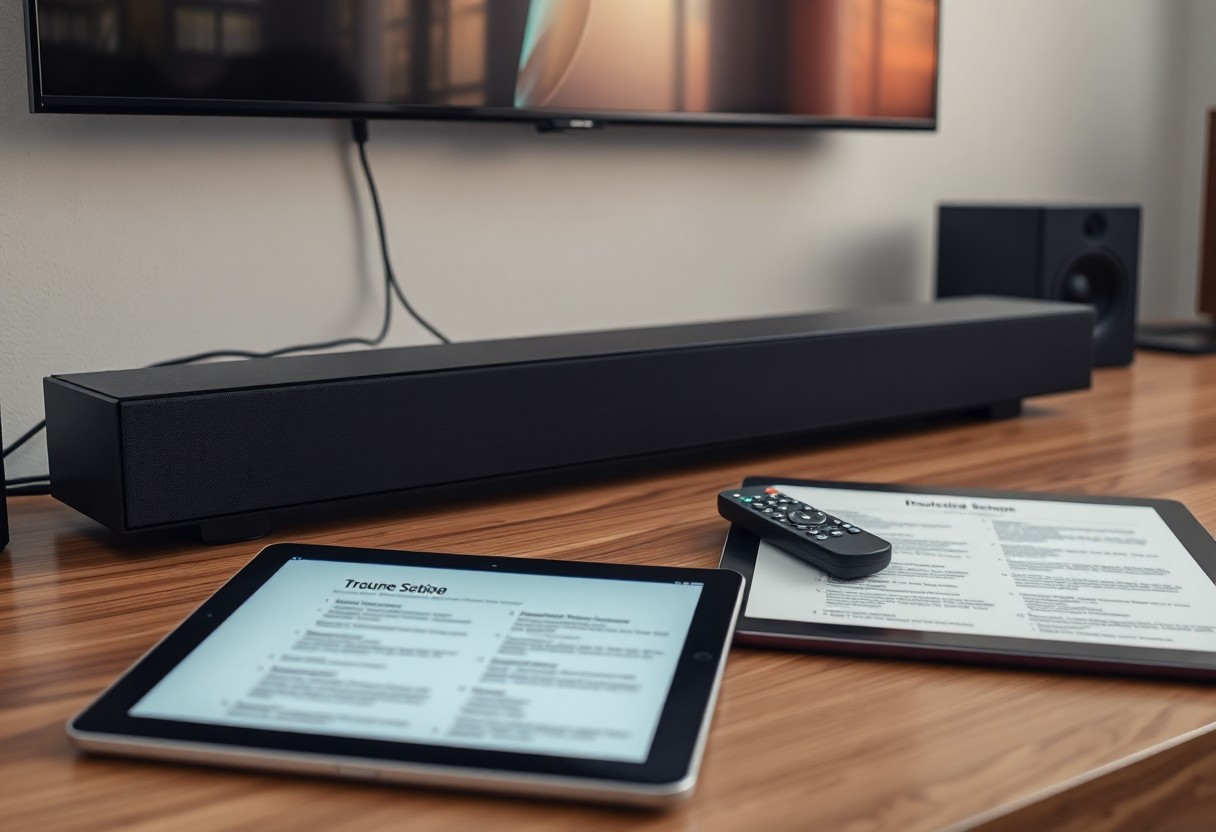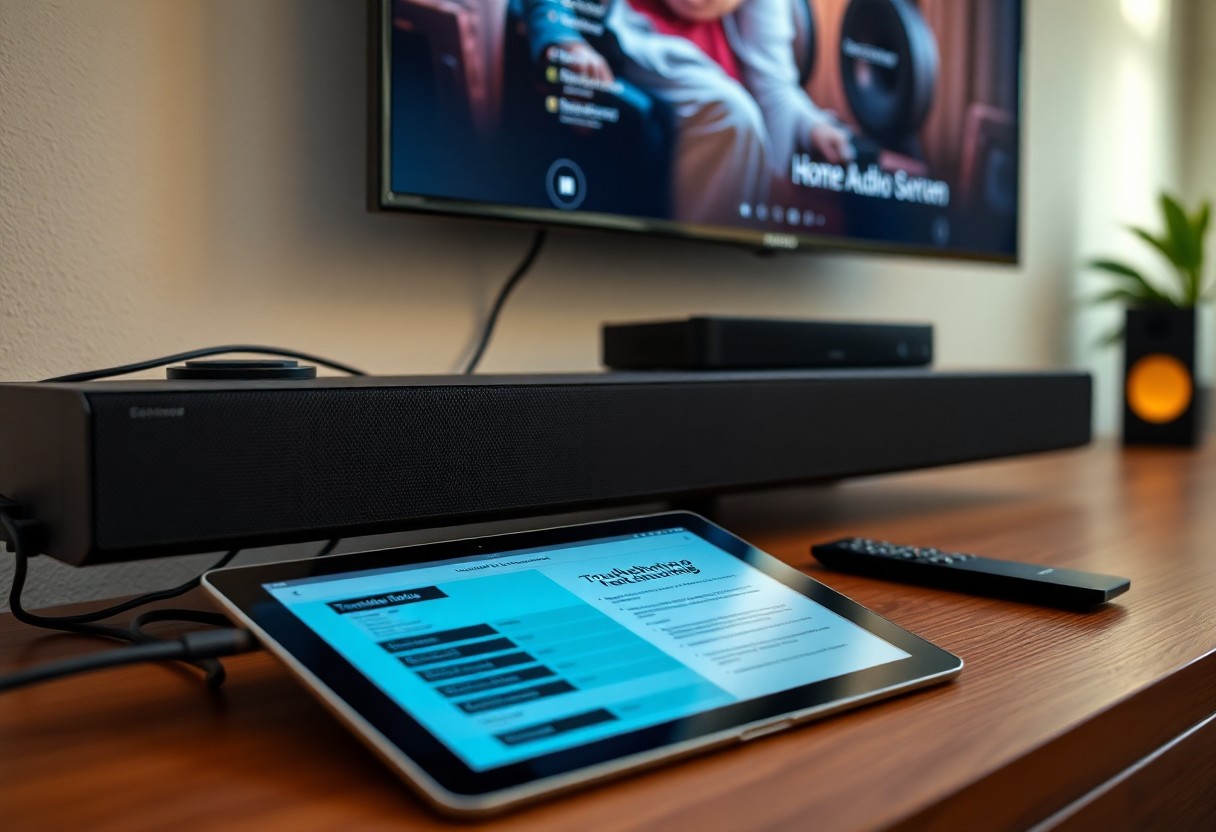Problems with your soundbar can be frustrating and disruptive to your entertainment experience. In this comprehensive guide, you will discover effective solutions to common soundbar issues that you may encounter. Whether you’re dealing with connectivity troubles, audio discrepancies, or remote control malfunctions, this guide will empower you to troubleshoot these problems with confidence. By following the steps outlined here, you can restore your soundbar’s performance and enjoy your favorite shows and music seamlessly.
Contents
Types of Soundbar Problems
While soundbars enhance your audio experience, they can encounter specific issues over time. Common problems include:
- Connection Issues
- Audio Quality Problems
- Power Issues
- Remote Control Malfunctions
- Firmware Update Failures
Thou must understand these issues to maintain your soundbar’s performance.
| Connection Issues | Problems with Bluetooth or HDMI connections. |
| Audio Quality | Distorted or unclear sound output. |
| Power Issues | Device won’t turn on or loses power. |
| Remote Control | Unresponsive or occasionally malfunctioning remote control. |
| Firmware Updates | Difficulty in performing software updates. |
Connection Issues
There’s nothing more frustrating than a soundbar that won’t connect properly to your TV or other devices. Often, these issues arise from incorrect settings, incompatible cables, or wireless interference. Ensure that your soundbar and the source device are on the same network, and check that all connections are securely plugged in. Diagnosing and addressing these problems can dramatically improve your overall experience.
Audio Quality Problems
Audio quality issues can detract from your viewing pleasure and alter your perception of a film or music. Poor sound can lead to muffled dialogue or lack of bass, making it hard for you to appreciate your favorite media.
To resolve audio quality problems, check the equalizer settings on your soundbar and adjust them to suit your preferences. Sometimes, positioning the soundbar away from walls helps reduce distortion. In addition, ensure that the audio format from your source device is compatible with your soundbar. Regularly updating your firmware ensures optimal performance and can enhance the overall listening experience.
Tips for Effective Troubleshooting
If you encounter issues with your soundbar, an organized approach can simplify the troubleshooting process. Follow these tips:
- Read the user manual thoroughly.
- Check cable connections and power sources.
- Restart the soundbar and associated devices.
- Adjust your sound settings on device interfaces.
- Update software/firmware when necessary.
Perceiving the solution as a gradual process can minimize frustration.
Basic Checks
Troubleshooting your soundbar begins with some basic checks. Ensure that all connections are secure and the soundbar is powered on. Check whether the correct input is selected and confirm that your device’s audio output settings align with the soundbar. Additionally, inspect the remote control batteries and the soundbar’s volume level.
Advanced Solutions
If basic checks don’t resolve the issue, consider implementing some advanced solutions. This could involve:
- Resetting the soundbar to factory settings.
- Testing with different audio sources.
- Adjusting audio formats in settings.
StepAction
| 1 | Power off your soundbar. |
| 2 | Locate the reset button (if applicable). |
| 3 | Hold the reset button for the designated time. |
If your soundbar continues to malfunction after these steps, consider checking for firmware updates. Keeping your soundbar’s software up to date can resolve many issues! For instance, you might want to:
- Visit the manufacturer’s website for updates.
- Use a USB stick if required for updating.
- Refer to your user manual for specific instructions.
Update StepsAction
| 1 | Connect your soundbar to the internet. |
| 2 | Navigate to the settings menu. |
| 3 | Check for software updates. |
Implementing these advanced solutions can drastically improve your soundbar’s performance and resolve ongoing issues.
Step-by-Step Troubleshooting Guide
Assuming your soundbar isn’t functioning as expected, following a systematic troubleshooting guide can resolve most issues. Start by identifying the specific problem before proceeding to implement effective fixes. Below is a structured approach to help you navigate through common soundbar challenges seamlessly.
| Step | Action |
| 1. | Check the power connection. |
| 2. | Inspect HDMI or optical cables. |
| 3. | Verify sound settings on your device. |
| 4. | Update firmware if necessary. |
| 5. | Reset the soundbar to factory settings. |
Identifying the Problem
Identifying the specific issue with your soundbar requires keen observation. Begin by noting any irregularities in sound quality, connectivity problems, or control issues. Are there missing audio outputs or strange pop sounds? By pinpointing these symptoms, you can streamline the troubleshooting process and apply the most appropriate solutions tailored to what you are experiencing.
Implementing Fixes
Any fixes you choose to implement should be systematic and based on the symptoms you’ve identified. Start with the simplest solutions, like checking connections, and progressively move to more complex strategies such as firmware updates or resets. Ensuring each step is thoroughly executed will enhance the likelihood of resolving your soundbar’s issues effectively.
Troubleshooting soundbar problems can often be accomplished with straightforward methods. Once you’ve diagnosed the problem, take action by ensuring all connections are secure, settings are adjusted correctly, and software is updated. If initial steps fail, consider factory resetting the device to restore it to its default settings, which can often resolve lingering issues. Continue with a methodical approach, and you will likely find a solution to your soundbar troubles.

Factors Influencing Soundbar Performance
Your soundbar’s performance can be impacted by a variety of factors, including:
- Room acoustics
- Connection type (HDMI, optical, Bluetooth)
- Soundbar placement
- Device compatibility
Recognizing these factors can help you enhance your soundbar experience. For more insights, check out How to Fix Common Soundbar Problems.
Environmental Considerations
Some environmental factors can affect sound quality, such as the size and shape of the room, furniture placement, and wall materials. These elements contribute to sound reflection and absorption, impacting overall audio clarity. Make sure your soundbar is positioned for optimal sound distribution, which can enhance your listening experience.
Device Compatibility
If your soundbar is not functioning properly, it might be due to compatibility issues with your other devices, such as your TV, gaming console, or streaming device. Ensure that your soundbar supports the connection types your devices use.
Compatibility is vital for a seamless audio experience. Always check the specifications of your soundbar and other devices to ensure they can communicate effectively. This includes verifying supported audio formats and connection protocols, as mismatched technologies can lead to sound quality issues or even no sound at all.
Pros and Cons of Soundbars
Once again, evaluating the pros and cons of soundbars can help you decide if they meet your audio needs. By weighing the benefits against the drawbacks, you’ll be better equipped to enhance your home entertainment system.
Pros and Cons of Soundbars
| Pros | Cons |
|---|---|
| Compact size and space-saving | Limited surround sound experience |
| Easy setup and installation | Sound quality may not match high-end systems |
| Affordable compared to traditional sound systems | Subpar bass without a subwoofer |
| Multiple connectivity options | Less customization of sound settings |
| Stylish design complements modern TVs | Some models may lack advanced features |
Advantages
An advantage of soundbars is their compact design, which means they can fit in tight spaces while still delivering enhanced audio performance. The ease of installation allows you to quickly set up your soundbar without complicated wiring, making it perfect for casual users.
Limitations
Limitations of soundbars include a compromised surround sound experience, which might not satisfy audiophiles or movie enthusiasts. You may find that while the sound quality is decent, it may not match that of a full home theater setup.
Soundbars typically offer limited bass response without a dedicated subwoofer, so you might miss that rumbling effect in action scenes. Additionally, the customizable sound settings may not provide the depth of adjustment that traditional surround sound systems allow, potentially hindering your overall listening experience.

Additional Resources for Soundbar Support
Unlike other audio devices, soundbars may require specific troubleshooting approaches. To ensure you maximize your soundbar’s potential, consider exploring various resources available to assist you in resolving issues effectively. From manufacturer websites to community forums, these resources can provide you with valuable insights and solutions tailored to your soundbar model.
Manufacturer Support
Soundbar manufacturers often provide dedicated support channels, including FAQs, live chat, and customer service hotlines. You can access user manuals, firmware updates, and troubleshooting guides specific to your model on their official websites. Utilizing these resources will help you find solutions directly related to your soundbar’s make and model.
Online Communities
To enhance your troubleshooting experience, online communities can be an excellent resource for users like you. These communities consist of fellow soundbar owners who share tips, tricks, and experiences concerning common issues or upgrades.
Manufacturer support serves as the primary line of assistance for your soundbar inquiries, while online communities offer a wealth of peer-supported information. Engaging with these forums allows you to share your experiences and gain insights from others who have faced similar challenges, enhancing your overall troubleshooting process and knowledge base.
Final Words
Presently, you have a comprehensive understanding of troubleshooting common soundbar problems, allowing you to confidently tackle issues as they arise. By implementing the steps outlined in this guide, you can optimize your soundbar’s performance, ensuring a seamless audio experience. Whether it’s connectivity issues, sound distortion, or remote control malfunctions, you are now equipped with the tools to diagnose and resolve these challenges effectively. With a proactive approach, you can enjoy enhanced sound quality and longevity from your soundbar, ensuring you get the best out of your audio setup.

Leave a Reply